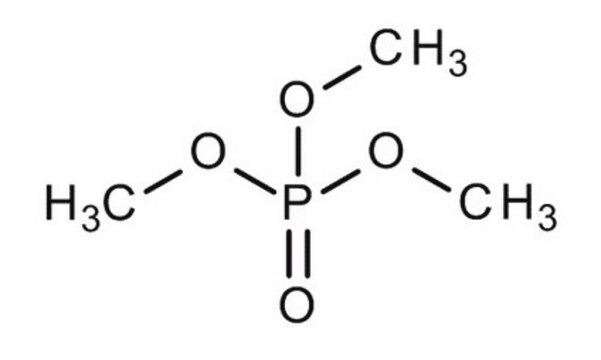Wszystkie zdjęcia(1)
Key Documents
About This Item
Wzór empiryczny (zapis Hilla):
C2H7O4P
Masa cząsteczkowa:
126.05
Numer WE:
Numer MDL:
Kod UNSPSC:
12352200
Identyfikator substancji w PubChem:
Polecane produkty
Postać
liquid
ciąg SMILES
O=P(OC)(OC)O
InChI
1S/C2H7O4P/c1-5-7(3,4)6-2/h1-2H3,(H,3,4)
Klucz InChI
KKUKTXOBAWVSHC-UHFFFAOYSA-N
Inne uwagi
Please note that Sigma-Aldrich provides this product to early discovery researchers as part of a collection of unique chemicals. Sigma-Aldrich does not collect analytical data for this product. Buyer assumes responsibility to confirm product identity and/or purity. All sales are final.
NOTWITHSTANDING ANY CONTRARY PROVISION CONTAINED IN SIGMA-ALDRICH′S STANDARD TERMS AND CONDITIONS OF SALE OR AN AGREEMENT BETWEEN SIGMA-ALDRICH AND BUYER, SIGMA-ALDRICH SELLS THIS PRODUCT "AS-IS" AND MAKES NO REPRESENTATION OR WARRANTY WHATSOEVER WITH RESPECT TO THIS PRODUCT, INCLUDING ANY (A) WARRANTY OF MERCHANTABILITY; (B) WARRANTY OF FITNESS FOR A PARTICULAR PURPOSE; OR (C) WARRANTY AGAINST INFRINGEMENT OF INTELLECTUAL PROPERTY RIGHTS OF A THIRD PARTY; WHETHER ARISING BY LAW, COURSE OF DEALING, COURSE OF PERFORMANCE, USAGE OF TRADE OR OTHERWISE.
NOTWITHSTANDING ANY CONTRARY PROVISION CONTAINED IN SIGMA-ALDRICH′S STANDARD TERMS AND CONDITIONS OF SALE OR AN AGREEMENT BETWEEN SIGMA-ALDRICH AND BUYER, SIGMA-ALDRICH SELLS THIS PRODUCT "AS-IS" AND MAKES NO REPRESENTATION OR WARRANTY WHATSOEVER WITH RESPECT TO THIS PRODUCT, INCLUDING ANY (A) WARRANTY OF MERCHANTABILITY; (B) WARRANTY OF FITNESS FOR A PARTICULAR PURPOSE; OR (C) WARRANTY AGAINST INFRINGEMENT OF INTELLECTUAL PROPERTY RIGHTS OF A THIRD PARTY; WHETHER ARISING BY LAW, COURSE OF DEALING, COURSE OF PERFORMANCE, USAGE OF TRADE OR OTHERWISE.
This page may contain text that has been machine translated.
Hasło ostrzegawcze
Danger
Zwroty wskazujące rodzaj zagrożenia
Zwroty wskazujące środki ostrożności
Klasyfikacja zagrożeń
Acute Tox. 4 Dermal - Acute Tox. 4 Oral - Aquatic Chronic 3 - Eye Dam. 1 - Skin Corr. 1B - Skin Sens. 1
Kod klasy składowania
8A - Combustible corrosive hazardous materials
Klasa zagrożenia wodnego (WGK)
WGK 3
Temperatura zapłonu (°F)
Not applicable
Temperatura zapłonu (°C)
Not applicable
Wybierz jedną z najnowszych wersji:
Certyfikaty analizy (CoA)
Lot/Batch Number
Przepraszamy, ale COA dla tego produktu nie jest aktualnie dostępny online.
Proszę o kontakt, jeśli potrzebna jest pomoc Obsługa Klienta
Masz już ten produkt?
Dokumenty związane z niedawno zakupionymi produktami zostały zamieszczone w Bibliotece dokumentów.
Klienci oglądali również te produkty
Taku Matsushita et al.
Water research, 138, 67-76 (2018-03-25)
Removal efficiencies of 28 pesticide transformation products (TPs) and 15 parent pesticides during steps in drinking water treatment (coagulation-sedimentation, activated carbon adsorption, and ozonation) were estimated via laboratory-scale batch experiments, and the mechanisms underlying the removal at each step were
Yan Zhang et al.
American journal of epidemiology, 189(5), 375-383 (2019-12-18)
Organophosphates (OPs) are the most heavily used pesticides in China. The Chinese population, including preconceptional women, is highly exposed, yet little is known regarding the associations between OP exposure and menstruation in humans. We conducted a cross-sectional analysis in women
Abigail Gaylord et al.
Molecular and cellular endocrinology, 502, 110666-110666 (2020-01-19)
Endocrine disrupting chemicals are known to cause neurodevelopmental toxicity through direct and indirect pathways. In this study we used data from the National Health and Nutrition Examination Surveys, along with known exposure-disease relationships, to quantify the intellectual disability burden attributable
Ian E Cock et al.
Pharmacognosy research, 3(2), 85-94 (2011-07-21)
Scaevola spinescens is an endemic Australian native plant with a history of use as a medicinal agent by indigenous Australians. Yet the medicinal bioactivities of this plant are poorly studied. S. spinescens solvent extracts were tested for antimicrobial activity, antiviral
Xiuzhong Wang et al.
Langmuir : the ACS journal of surfaces and colloids, 34(26), 7899-7905 (2018-06-12)
Phosphate-containing molecules exist in many forms in biology and the environment, and their interaction with metal oxides is an important aspect of their chemistry and biochemistry. In this work, phosphates with different degrees of polymerization (e.g., orthophosphate, pyrophosphate (PPi), sodium
Nasz zespół naukowców ma doświadczenie we wszystkich obszarach badań, w tym w naukach przyrodniczych, materiałoznawstwie, syntezie chemicznej, chromatografii, analityce i wielu innych dziedzinach.
Skontaktuj się z zespołem ds. pomocy technicznej












